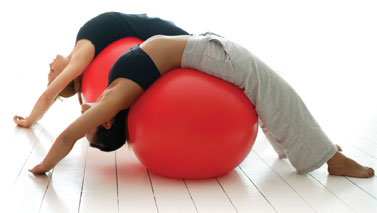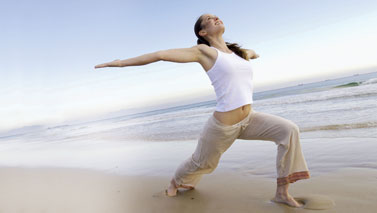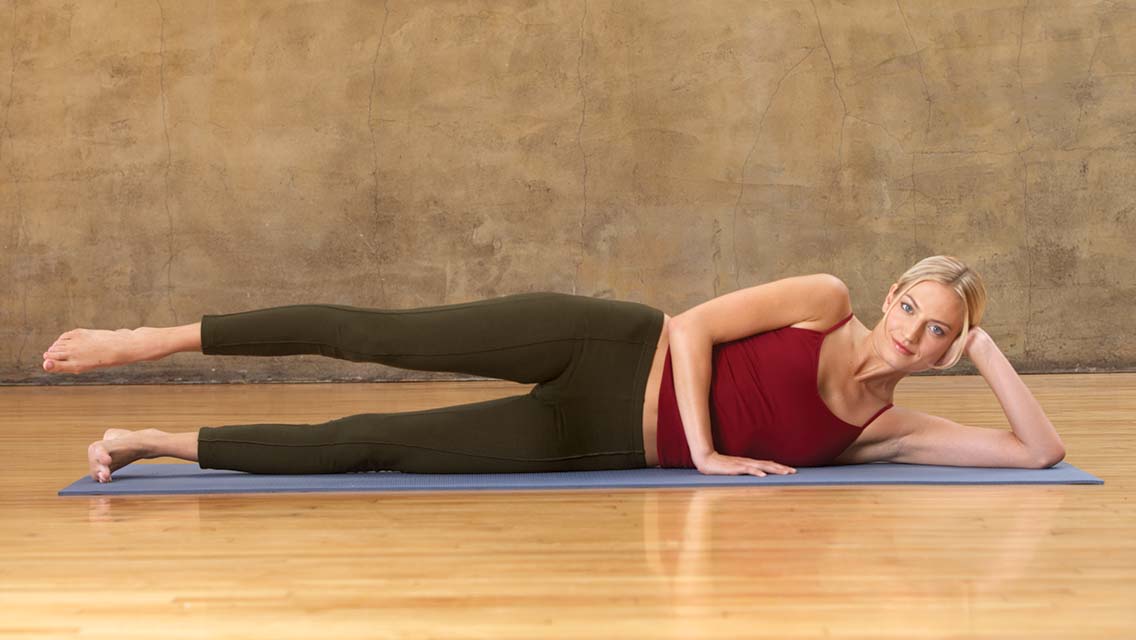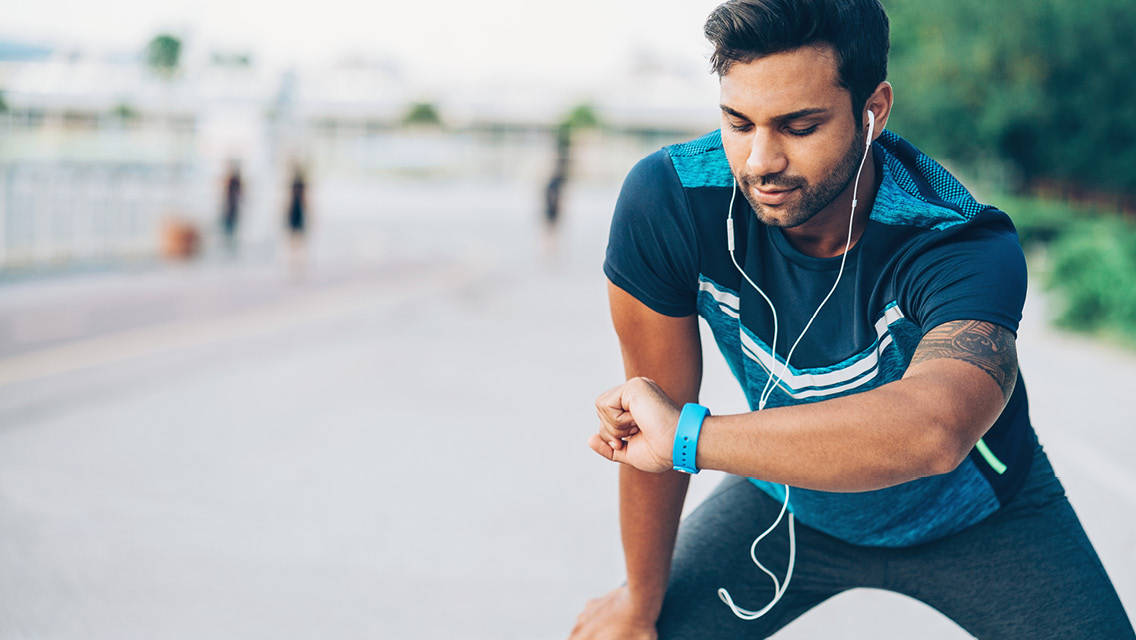Tired of your old fitness routine? You’re not alone. Millions of Americans are stepping away from grinding, unimaginative regimens in search of new, exciting ways to get into shape, tune in to their minds and bodies, and simply have more fun at the gym. And what are they finding when they look around? A lot — starting with an eclectic array of group-fitness classes (Body & Soul, Zumba, Nia and capoeira, to mention a few), plus hip-hop-inspired dance classes, power yoga and more. And there are new options in custom-tailored training programs based not just on your personal goals, but also on personalized factors such as your resting heart rate, anaerobic threshold and V02 max.
It’s all part of a recent movement away from the regimented, no-fun fitness philosophies of the last few decades. The “no pain, no gain” approach is out; the joyful workout is in. Young and old, heavy and thin, male and female, shy and outgoing — there’s something for everyone.
“We’re undergoing a fitness revolution,” notes personal trainer Jackie Warner, star of Bravo TV’s Work Out. Warner says she’s observed this trend in beauty-obsessed, health-conscious Los Angeles for the past several years, but lately that craze is making its way into gyms all over the country.
The reason? While Americans finally seem ready to fight the obesity epidemic, they also realize that life is too short to trudge through a miserable fitness routine. More than 80 percent of Americans are sold on the idea of fitness, according to American Sports Data, Inc. (ASD), a leading sports and fitness research firm. But only 17 percent describe themselves as hardcore participants, willing to work out in any situation, at any time.
Most of those remaining want to get into better shape but are waiting to be inspired. They might be self-conscious and intimidated by traditional fitness regimes, ASD notes, or they may just be hungry for a more rewarding experience — and so the industry is responding with more user-friendly options.
The American Council on Exercise (ACE) has noticed the tidal shift as well. In their 2008 fitness-trend predictions, ACE experts pointed to outside-the-box workouts, equipment-free workouts, personal training, technology-based workouts and a focus on total wellness.
“People will only adhere to something if it’s enjoyable,” says Cathy Roy, PhD, associate professor of exercise science at Longwood University in Farmville, Va. Her ongoing research has shown that up to 60 percent of those surveyed do not engage in regular exercise (a 2007 National Center for Health Statistics survey put that number at 70 percent). The most common reasons, notes Roy, are lack of time and enjoyment.
Thankfully, the focus of fitness is changing, and it’s never been easier to try something new. Whether you’re interested in functional fitness, mind-body meditation, learning how heart-rate training works or just shedding a few pounds by moving to music, there are now more choices than ever. (For more on discovering what inspires you, see “Feeling Groovy: A Fitness Primer” in the July/August 2005 archives.)
We asked several experts and fitness enthusiasts to help us navigate a handful of the latest exercise options. Use the following guide to find a program that will inspire you to get moving in more joyful ways.
The Trend—Feel-Good Creative Expression
The Players—Nia, Moving Meditation, Body & Soul classes and more
In our techno-crazed, overworked, type-A world, finding time to relax and be creative can feel daunting, even indulgent. But therapeutic disciplines such as Nia, which combines martial arts, healing arts and dance, have been shown to help people become more connected with their bodies and emotions — and relieve stress.
“Nia is movement as medicine,” says Jeff Stewart, chief executive officer for Nia Technique, Inc. “It’s dynamic, expressive, sensual, and it’s a highly effective form of fitness-building exercise.”
Similarly, creative fitness approaches such as Moving Meditation, Body Joy, Soul Motion, Body & Soul and Trance Dance are designed to awaken the spirit and communicate with the soul through free-flowing movements and dances.
Some classes, such as Body Joy, borrow from yoga, meditation and physical therapy practices, while others, such as Trance Dance, are inspired by ancient dances and upbeat music like jazz and funk. Trance Dancers wear bandannas over their eyes to help them ignore what others around them are doing and connect more fully with their own body’s movements.
In this same category is a discipline called 5Rhythms, created by body-mind visionary Gabrielle Roth, which emphasizes what she calls the five major rhythms: flowing, staccato, chaos, lyrical and stillness.
Participants improvise movements in each of these categories, beginning with a warm-up during which they tune out their busy days, followed by a musical wave of free-form dance and finally a closing circle that allows the group to process the experience.
In a world of crisis, Roth notes, 5Rhythms offers a way to meditate, stimulate awareness and work out in the same breath.
And as Jeff Klein, 50, of San Rafael, Calif., discovered, it can also be emotionally healing. In January 2007, while in the midst of a painful divorce, Klein began participating in “Sweat Your Prayers” — a public practice session of the 5Rhythms program. “I was deeply engaged in a difficult custody process and looking for relief, community and healing,” he recalls.
Unlike yoga, which is more introspective, the 5Rhythms program forced Klein to connect with others while also evaluating his own state of mind and healing. “I can have a deeply internal experience, a powerful outer experience with others, and both in the same session,” he explains. Plus, there’s an added bonus: endorphins. “I sweat profusely and work my whole body at the same time I’m working out emotional issues, exploring other people’s energy and having great fun.”
The Trend—World Dance
The Players—Workouts inspired by belly dancing, African dance, capoeira, Zumba and hip-hop
Don’t have time to travel to faraway lands? Take an inspired fitness class instead. “Some people experience world culture through reading a book, traveling or watching a foreign film, while others do it through a Zumba class,” says Warner.
Hip-hop aerobics classes are nothing new, but many gym-goers are rediscovering how fun they can be, along with belly dancing and newer offerings such as African dance and Zumba, a Latin-dance inspired workout that includes irresistible music and rhythmic cardio moves that follow an interval-training pattern.
Music is Zumba’s secret weapon, and it’s a motivational tool with proven results. A handful of studies published in the past decade found that listening to upbeat music while working out actually lessens the discomfort often associated with cardiovascular exercise. In other words, when you listen to something you like, you don’t feel the burn.
“The appeal of these classes is the authentic relationship between the movement and the music,” says Kelly McGonigal, PhD, a mind-body psychologist and fitness instructor at Stanford University. “The experience taps into our primal need for moving our body to a rhythm.” As a result, your brain releases a flood of feel-good neurotransmitters and endorphins that we would associate with the high of a rock concert, a great party or singing at your church.
If you’re looking for a slightly edgier dance class, you might prefer capoeira, a Brazilian martial-arts-inspired dance that’s gaining popularity nationwide thanks to professional “capoeiristas” appearing in television commercials and music videos by the Black Eyed Peas and Wyclef Jean, among others.
“Dancing is a great sculptor of the muscles and a fun way to build community,” says Sarah-Jane Romano, 34, a longtime fitness-dance and Zumba teacher in Del Mar, Calif. Romano says she noticed her natural flexibility declining as she entered her 30s and was looking for a way to gain it back while learning something new. She signed up for Zumba and eventually moved on to modern dance classes, as well as ballet, jazz and hip-hop. “Having to learn new combinations of steps really sharpens my mental connection with my body and clears my head,” she notes. “Plus, dancing for fitness brings people together and doesn’t require any fancy equipment — just your feet!”
The Trend – Breathe, Stretch and Center
The Players—Yoga, Pilates, tai chi, qigong
Practices such as yoga, Pilates and tai chi are not only relaxing, they’ve been credited with helping to relieve depression and anxiety, improve posture, and reduce back pain. Plus, they enhance your mind-body connection, says fitness and stress-management expert Debbie Mandel, MA, author of Addicted to Stress: A Woman’s 7-Step Program to Reclaim Joy and Spontaneity in Life (Jossey-Bass, 2008). The precise core-strengthening and stretching moves require thoughtful breathing and meditation, which are great tools for getting in touch with your body and your mind’s inner workings.
All yoga classes focus on a series of poses and deep breathing, though some are more meditative, and others are more physical. For instance, hatha yoga is a gentle practice that emphasizes flexibility; Ashtanga is a more intensive strength workout; hot, or Bikram, yoga, is fast paced and takes place in a heated room, making it more challenging. And power yoga incorporates several poses performed in quick succession for a more vigorous, cardiovascular workout.
Pilates, on the other hand, was developed in part to help dancers and gymnasts improve their posture and strengthen their core. It follows a series of controlled resistance-training moves, stretches, deep breathing and whole-body strengthening.
“The problem is that the average person uses only the top third of their lungs,” says Pat Guyton, a master Pilates teacher based in Boulder, Colo. Rounded shoulders and a slouching back cause the rib cage to sink, crowding the diaphragm and the lungs, Guyton notes. But practicing Pilates aligns the spine, allowing participants to use their full lung capacity. (For more on the benefits of Pilates, see “Pilates Power” in the January/February 2007 archives.)
Tai chi and qigong are both ancient Chinese martial arts that promote longevity and good health. Tai chi tends to emphasize circular movement, stress relief and self-defense, while qigong focuses on breath work and the “life force” linked to vitality.
Unlike more-energetic workouts, such as Zumba or kickboxing, flexibility-focused classes may require more patience to see results. (For more on savoring subtle fitness breakthroughs, see “Small Victories” in the April 2008 archives.) But the results can be dramatic. Many people experience an abatement of aches and pains that have bothered them for years; others discover inner strength they never realized they had.
Elizabeth Lichtenstein, 41, of Lafayette, Colo., began taking yoga classes several years ago to help with a chronic shoulder injury. She enjoyed the classes so much that, when she became pregnant last year, she signed up for prenatal yoga to help ease the inevitable aches and pains. “I found that the yoga training and breathing and the concept of ‘practice’ was empowering,” notes Lichtenstein. “So much so that I powered through 28 hours of natural childbirth.”
The Trend—Personalized Programming
The Players—Heart-rate training, personal training, functional fitness and more
If you’re driving toward a specific fitness goal, stuck at a plateau, or feeling in need of augmented accountability and intensity, personalized fitness programs are a great way to go. Working one-on-one with a trainer or in a small-group setting provides an ideal context for focusing on your objectives, your body and your lifestyle. After all, your fitness program is about you. And if you schedule an appointment and don’t show up, you can bet your trainer will notice.
To ensure that you’re working out at the proper intensities, many trainers today are emphasizing both fitness testing and heart-rate training — a methodology that establishes optimal exercise intensities (or “zones”), durations, and frequencies based on your metabolism, heart rate, current level of fitness, and health or fitness goals.
Most people tend to overestimate their daily caloric expenditure and underestimate their caloric intake, but by evaluating your Resting Metabolic Rate (RMR) and VO2 max, a good trainer can give you highly specific recommendations that help you achieve the results you’re after — without working yourself into the ground.
“Metabolic testing gives you an individual thumbprint as to what’s going on inside your body,” explains Jeff Rosga, national director of fitness research for Life Time Fitness. Quite simply, RMR tells you how many calories your body needs to function, while VO2 max tells you how your body uses those calories during cardiovascular exercise. And with that knowledge, says Rosga, you can better understand how to get your body to perform better — go faster or for longer — or burn more fat calories. (For more about the benefits of heart-rate training, see “A Better Way to Burn Fat” in the January/February 2007 archives.)
If one-on-one training is too pricey, check out one of the many small-group training classes that are sprouting up at gyms nationwide. Often limited to five or fewer participants, these classes offer a more personal approach than regular fitness classes, yet cost only a quarter to half of what a personal trainer would charge. Some gyms encourage friends to sign up together so that they feel more at ease and can hold each other accountable for attending.
If conventional treadmill and other machine-based workouts aren’t your style, look into a functional-fitness class that emphasizes real-life movements and challenges, often with little or no complex equipment involved.
Jon Hinds’s Monkey Bar Gym in Madison, Wis., is almost completely devoid of conventional equipment, and that’s the appeal, says Hinds, a certified strength and conditioning specialist. Gym members tend to leave their MP3 players at home, too, because they spend the majority of their time directly engaged with the trainers.
“‘Extreme Functional Training’ is a good way to describe what we do,” Hinds explains. “It’s helping people to move as nature intended — to run, to jump, to climb, to crawl, to react — so that they can improve their health and how they function in the world around them.” Hinds emphasizes proper alignment of the spine, as well as joint stability, which helps clients avoid injuries, especially as they get older.
And what if a monkey-inspired or super-expressive workout isn’t for you? No problem. The beauty of having so many new exercise choices is that you can sample them and discover what motivates you to get moving.
“For me, music is a must,” Warner says. But others might prefer the quiet, meditative environment that a yoga class provides. It’s like discovering new cuisines or fine wines — you’ll never know what brings you the most enjoyment until you look at the menu and give something a try.
Match Making
With so many trendy new classes to choose from, you might not be entirely sure where to start. Use this chart to help you home in on the trends best geared to your fitness goals — and your personal preferences.
Your Goal: Lose weight
Trend to Try: Personalized Programming, World Dance
Your Goal: Have fun
Trend to Try: World Dance, Feel-Good Creative Expression
Your Goal: Express yourself creatively
Trend to Try: Personalized Programming, World Dance
Your Goal: Relieve stress
Trend to Try: Breathe, Stretch and Center; Feel-Good Creative Expression
Your Goal: Build self-esteem
Trend to Try: World Dance, Feel-Good Creative Expression
Your Goal: Improve your balance
Trend to Try: Breathe, Stretch and Center; Personalized Programming
Your Goal: Strengthen your core
Trend to Try: Breathe, Stretch and Center; Personalized Programming
Your Goal: Meet new people
Trend to Try: World Dance, Feel-Good Creative Expression
Your Goal: Run a faster road race
Trend to Try: Personalized Programming
Your Goal: Overcome or prevent an injury
Trend to Try: Breathe, Stretch and Center; Personalized Programming




This Post Has 0 Comments